#okinawan
Explore tagged Tumblr posts
Text

shimanchu (indigenous okinawan) miku for the miku worldwide thing‼️
she has hajichi (cultural tattooing practice), and wears usinaasugai/ushinchi/ryusou dress with traditional textile bingata and kasuri patterns and a hanagasa hat
#hatsune miku#shimanchu#uchinaanchu#okinawan#okinawa#digital art#hatsune miku fanart#indigenous#east asian#my art
365 notes
·
View notes
Text
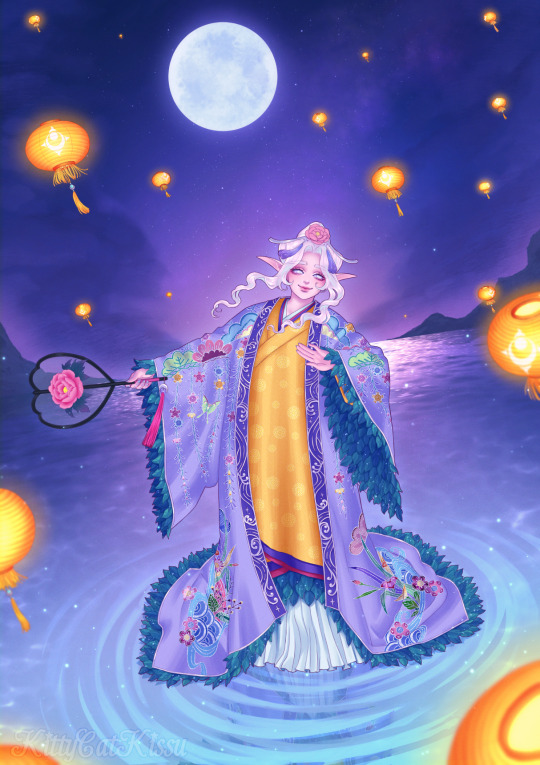




🏮Moonlit New Year🏮
#world of warcraft#warcraft#night elf#kaldorei#lunar festival#lunar new year#ryukyu#okinawan#uchinanchu#stellanaria starweaver
77 notes
·
View notes
Text
Ryukyu Clothing (Ryusou/Uchinaasugai - "Kimono")
PSA: I am not a professional dresser or historian and finding this information is more of a cultural hobby. Please correct me if you see any discrepancies.
From a Ryukyuan-language standpoint, I don't think it's appropriate for Ryukyuan clothing to be called "Kimono" because it isn't Japanese. The general term meant to talk about Okinawan clothing in the Ryukyuan Kingdom context is 琉装 (Ryusou in Japanese/Uchinaasugai ウチナースガイ in Uchinaaguchi). I'm calling it "Kimono" here because it's the most easily understandable. Additionally, this post will not include textiles from the Amami or Ishigaki region and focuses on Uchinaa.
Most Ryukyuan clothing is made for the weather of the region, which can be more humid and hot than Japan. Sadly, if there was record of Ryukyuan clothing before the Kingdom era, it's lost to history. Being a region of trade, a lot of clothing takes inspiration from the many cultures and countries the Ryukyus were in contact with (Southeast Asia, East Asia). Textiles that included Bingata, Kasuri, Silk, or Patterns were for those of upper classes.
I think the most well known style of Ryusou is the one that incorporates a Bingata robe over ウシンチー (Ushinchii). The robes were made of silk and was usually worn by the upperclass citizens in the Ryukyu Kingdom. They tend to have larger sleeves for air. It also tends to fit "loose" since it's very easy to sweat in the region. For men and women formal attire consists of a two-piece outer garment worn over an underwear garment.
ウシンチー Ushinchi
Below is an example of me being dressed in a ウシンチー (Ushinchii) style, which as you can see in this situation the ウシン (Ushin) sash is small. Doesn't always incorporate Kasuri, sometimes it's a solid color. Sometimes it will incorporate other Ryukyuan style clothing.

This is a more formal style of dress but this is an example of one look when they are paired together.

ドゥジン & カカン Duujin and Kakan
There are other clothes for women like one worn by court ladies that are "two pieces" likeドゥジン (Upper piece) and カカン (skirt). They can also have a Bingata robe worn over it. I believe the Kakan is inspired by the Hanfu and Mamianqun.

(Source)
ハチマキ Hachimaki
For formal wear for men in upper classes, the clothes tend to be more simple. They wear a ハチマキ (Hachimaki) which is a hat meant to denote your rank. Men also would tend to wear thicker sashes or obi than women.
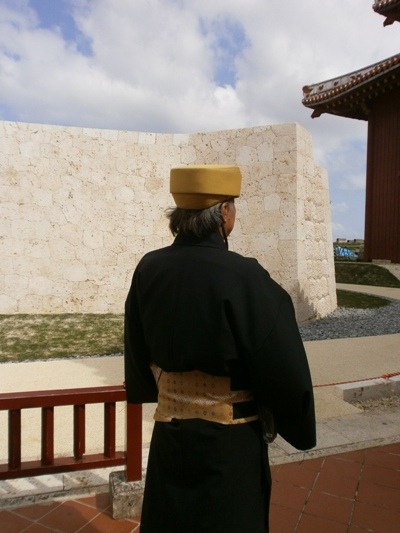
(Source)
芭蕉布 Bashofu
For common people, I don't know what the name for the attire would be but it was made of Bashofu (banana fibre). Now the textile is quite rare and sought after but before the war, it was commonplace to wear and typically worn much shorter than a Japanese kimono (around the shins). It was a relatively breathable fabric and the sleeves are more like open sleeves than what a kimono is like.
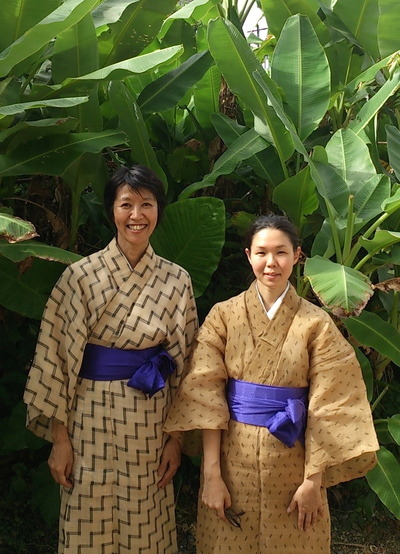
(Source)
There are more names, terms, and history that I need to learn but thank you for reading this.
#ドゥジン#ウシンチー#琉装#Ryukyu#Ryukyuan#Clothing#Okinawa#Kimono#Long Post#琉球#芭蕉布#カカン#My Post#History#Culture#Okinawan#Ryusou#Duujin#Kakan#Bashofu#Hanfu#Fashion
142 notes
·
View notes
Text
Okinawa, Ryukyu Islands, Japan






#nature#hiking#travel#naturecore#travelcore#okinawa#ryukyu#japan#japan travel#asia travel#pacific islands#world war ii#sunsets#cherry blossoms#sakura#nature photography#travel photography#travel destinations#mountains#forests#cliffs#seaside#oceanside#islands#pacific ocean#japanese castle#okinawan#waterfalls#beaches
24 notes
·
View notes
Text




ೀㅤㅤ Okinawan Transfem
A flag for Okinawans(link) who identify as transfeminine or transwomen
ྀི◟ ͜ ̣̣̥⠀self indulgent, exclusive to okinawans & transfems. Transrace & Perisex AFAB tfems DNI

Do Not Interact
Basic dni, (disorder) abuse believers, endogenic/non-traumagenic systems, anti-good faith, anti-paraphilias, radqueers, harmful transids, perisex afab tfems and amab tmascs, anti-self diagnosis

#🍷. ︵ a lil smth for you#🕯️⸺ siin's coining#💌mail!#mogai#liom#mogai flag#mogai coining#mogai term#liom coining#mogai gender#Transfem#transfeminine#transwoman#okinawan#Okinawa#okinawan transfem#Japanese transfem#japanese
11 notes
·
View notes
Text





Okinawan vibes in Naha, Okinawa prefecture, Japan. 🇯🇵
沖縄県那覇市 🌊🌴





#Japan#Okinawa#🇯🇵#naha#Naha city#Okinawa prefecture#Okinawan#Japanese#japan beauty#japan photos#Japan travel#beach aesthetic#coastal Japan#travel#cities#beach#coastal city#coastal#sunny day#beachy vibes#island#island aesthetic#tropical#tropical island#tropical aesthetic#Japanese island#🎌#beach town#🗾
7 notes
·
View notes
Text
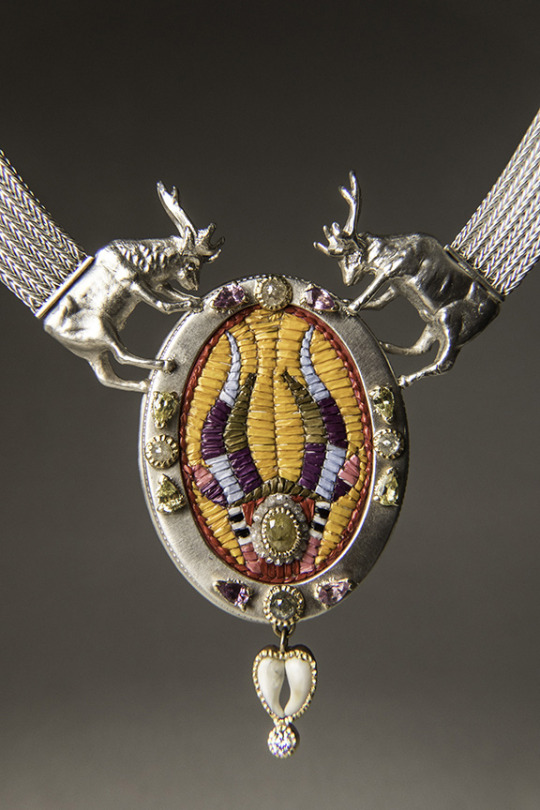

Elk Necklace collaboration between Keri Ataumbi & Jamie Okuma
#Keri Ataumbi#Kiowa#Jamie Okuma#Luiseño#Shoshone-Bannock#Wailaki#Okinawan#Jewelry#Silver#Quill Work#beadwork#Elk#contemporary art#indigenous art
28 notes
·
View notes
Text
Month wrap-up
Korean: 383 words this month, the biggest amount this year! This was my main focus this month. Picks of my favorite words from this month:
교대 交代 - taking turns 당청되다 當籤- - to win the lottery 마땅히 - properly 석화 石花 - oyster 일당백 一當百 - equal to 100 warriors 출하 出荷 - shipment
Japanese: only 57 words this time! I feel like I've studied more though. I've gotten better at listening! Favorite words:
いれい 慰霊 - consoling the dead しけ 時化 - stormy weather at sea でんち 電池 - battery よてい 予定 - plans
Mandarin and Cantonese: I haven't focused on these much this month. However I've been listening to both languages a bunch.
Mongolian: I haven't logged the words I know because I'm learning it with a different approach. But I've been studying it a lot and am learning a bunch of new words!
Toki Pona: I can now understand written text 99% of the time. I should practice writing next.
Okinawan: I've learn the Okinawan version of every Japanese word I've studied this month. I'm progressing steadily.
Other languages: I've been learning random words from other languages too. Notably Hungarian (Which I haven't learned at all in the past). Maybe I should start studying it regularly!
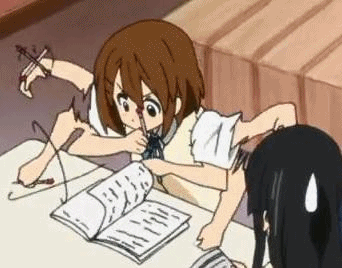
#langblr#language#korean#한국어#日本語#日本語勉強#mongolian#монгол хэл#toki pona#mandarin#cantonese#okinawan#hungarian#うちなーぐち#log#study blog#word list#studyblr
83 notes
·
View notes
Text




Easian4Easian (East-Asian 4 East-Asian
- not for RCTA people.
- Requests open!!
- Easian4 Easian : East Asian ppl who prioritize/prefer/only date other East Asian ppl.
- FLAG ID : 7 striped flag with a Pink Cherry Blossom in the middle.
- COLORS : Dusty Red, Light Dusty Red, Red-ish Pink, Pale Red, Red-ish Pink, Light Dusty Red, Dusty Red
- EXTRA : The colors were chosen due to many Easian flags having red and white in them! The flower is a Cherry Blossom also known as a Sakura, holds cultural significance in Easian Countries. Such as Japan, Korea, and China.



#🍤 !! Jiaming's Coining.. -𝄡#asian4asian#east asian#japanese#chinese#korean#cantonese#okinawan#ainu#taiwanese#mongolian#tibetan#x4x#x4x flag
12 notes
·
View notes
Text
Lee A. Tonouchi Special to Da Hawai‘i Herald
My great grandma who wuz born in Okinawa in 1885 had traditional Okinawan hand tattoos known as hajichi. Esteemed Okinawan cultural expert, Eric Wada of da eju-ma-cational group Ukwanshin Kabudan wen do field research on what motivated Okinawan women for get their hajichi. Wada Shinshï (teacher) shares “hajichi was around and in use from pre-contact times so there is no written documentation of exactly when and how it started, however through oral and documented information, it evolved into a woman’s right of passage to adulthood and had many other spiritual connections, such as genealogy, cosmology and social status.”
Growing up my great grandma felt ashamed of her tattoos cuz in Okinawa, Okinawans wuz coming for be made for feel ashamed of everyting Okinawan. When she came Hawai‘i to work plantation, my great grandma wuz so self-conscious that she made my grandma promise that when she ma-ke time, she wanted to be put in da casket with gloves on.
But how could something that wuz once one mark of great cultural pride transform into one mark of shame? Wada Shinshï explains, “hajichi was banned and discouraged after the illegal annexation and overthrow of the Ryükyü Kingdom in 1879, which resulted in implementation of assimilation programs by the Japanese government, which brainwashed the native people to be ashamed of their ‘savage’ cultural practices and assimilate to the modern and ‘civilized’ Japanese culture.”
For da past several decades dis art form for Okinawan women had been dying out to da point where I noticed that most of my younger friends in Okinawa had nevah even seen hajichi before. Das how rare it wuz.
Interestingly, in da past couple few years seems like get one revival going on. Wada Shinshï shares his mana‘o on dis phenomenon: “I am happily cautious about the hajichi resurgence and optimistic because things that have been put to sleep can come back. There will be individuals who just want to do it as a fad or without such deep connections, and that is their choice, but for the most part, I see more interest in reviving the tradition connected to the deeper spirituality and identity.”
Below get tree young Local Uchinänchu women and their hajichi stories.
Read more...
21 notes
·
View notes
Text
Queer Polyglot/Language Learning Community
Do you speak or have resources in any of these languages? I'm building an online dictionary of queer-related words (anything regarding sexuality, romantic orientation, gender expression, intersex traits, etc).
The languages I still haven't manage to get much from are (in no particular order):
Hmong
Yagan
Aonikenk
Manchu
Jeju
Okinawan
Ainu
Kakán
Ossetian
Even if you don't speak any of these, but you speak a language few people know, I'd love for you to reach out.
#hmong#yagan#aonikenk#tehuelche#jeju#manchu#ainu#okinawan#kaweskar#alacaluf#ossetian#lgbt#lgbtq#lgbtqia+#languages#langblr#polyglot#multilingual#bilingual#trilingual#native american#asian
4 notes
·
View notes
Text
Okinawan Verbal Morphology / 沖縄語の動詞形態論
Okinawan has an agglutinative morphology which involves “glueing together” bits of information. This is very similar to languages such as Japanese and Korean.
Okinawan, and many Ryukyuan languages, have retained some grammatical forms now obsolete in Modern Japanese. One of these is the attributive form. The present and past tense of verbs in Okinawan inflect for the attributive form, as well as a terminal form ie the dictionary form. However, other innovations have occurred in Okinawan such as losing the object marker and the subject and genetive marker sounding phonetically the same in certain contexts. In this lesson I will only teach the plain form to introduce the basic verbal morphology. I will also not be teaching the specific conjugation rules. A full list of tenses can be found at the end under further reading.
NOTES:
In all lessons, romanisation will not be used. A full guide to hiragana will be attached under further reading.
Lessons will include a colour code: new terms and concepts will be blue and feature focuses will be red. The words in blue will be defined at the bottom of the page under definitions.
Further reading gives additional resources which will help in your study of Okinawan.
Affirmative:
Present:
The present tense ending is simply the dictionary form of a verb.
For example:
咬むん(かむん) - to eat; (I) eat
言ん(っゆん) - to say; (I) say
考ーゆん(かんげーゆん) - to think; (I) think
聞ちゅん(ちちゅん) - to hear; (I) hear
話すん(はなすん) - to speak; (I) speak
Past:
All past tenses comprise of an alveolar consonant (or avleolo-palatal) + aん:
〜たん,〜ちゃん, 〜だん, 〜じゃん
For example:
咬だん - (I) ate
言ちゃん - (I) said
考げーたん - (I) thought
聞ちゃん - (I) heard
話ちゃん - (I) spoke
Negative:
Present:
The negative is a little bit less predictable since they are a mixture of alveolar sounds, [k] and [m]. They also are of the structure aん like the affirmative tenses:
あん, かん, がん, さん, らん, まん, だん
For example:
咬まん - (I) don’t eat
言やん(っやん) - (I) don’t say
考げーらん - (I) don’t think
聞かん - (I) don’t listen
話さん - (I) don’t speak
Past:
The past negative is actually pretty simple, it comprises of the negative form plus たん:
あんたん, かんたん, さんたん etc
For example:
咬まんたん - (I) didn’t eat
言やんたん - (I) didn’t say
考げーらんたん - (I) didn’t think
聞かんたん - (I) didn’t listen
話さんたん - (I) didn’t speak
Attributive:
The attributive form is made by removing ん and adding る in the present and present negative.
Examples:
広いさる(ふぃるさる)猫(まやー)- A big cat
話さんたる女子(うぃなぐ) - A woman who didn't speak
Conclusion:
This lesson was focused on the plain form present, past, negative and past negative forms. This was by no means a detailed guide of the individual rules. The attached Google Doc will give more information on the specific conjugation types arranged into tables. It also has other forms including the passive, desiderative and causative among others. That Doc will give the detail that this lesson was missing simply because there’s not much to say on the specific conjugation types that can’t be included in tables.
> Definitions:
• Agglutinative - from the Latin “agglūtinō”, “to glue (together)” which involves adding morphemes to a root. These morphemes usually don’t mean much (if anything) on their own. This is contrasted with fusional languages where one morpheme can be used in different situations and these are usually “words” as defined in English.
• Attributive Form - a form of a verb to use it to describe anything (in this case) after it ie as an adjective
• Object Marker - marks the object of a sentence ie the thing that the verb is affecting eg I eat watermelon, “watermelon” is the one receiving the “eating” - Japanese: 私は西瓜を食べる (watashi wa suika wo taberu), “wo” = object marker, marking “suika”. Okinawan: 我んねー西瓜咬むん (wannee shiikuwa kamun), lack of an object marker unlike Japanese.
• Subject Marker - the subject and topic markers are very similar in usage and both handle information being known or not. The best way to understand the usages is to see them in a sentence.
• Genetive Marker - this shows possession eg 猫ぬ目 (mayaa nu mii) - the eye of the cat. This marker is used in the same position as the ‘s strategy of possession in English eg the cat’s eye; the marker directly follows the possessee.
> Further Reading:
Full Conjugation Tables: https://docs.google.com/document/d/1-ew99qbNZHqpuNwDHYTzsTEpoLWdD1OANqWVic7LS4I/edit
Hiragana Tables: https://docs.google.com/document/d/12Z__i6Ay7wXm1H-40wLTqRKluyz_IlOYrRxrHWDnm8s/edit
16 notes
·
View notes
Text
I love this beautiful diverse family that I'm so thankful to be apart of :>
shout out to forgotten asians.
shout out to south asians: asians from india, pakistan, sri lanka, bangladesh, afghanistan, bhutan, maldives, nepal.
shout out to ignored east asians from countries less romanticized than china, japan, and south korea: to mongolia, taiwan, vietnam, and further southeast to singapore, malaysia, the philippines, east timor, brunei, cambodia, myanmar, laos, thailand, indonesia.
shout out to ethnic groups within more known asian countries, like the tibetan people in china and the ainu and ryukyuan people in japan.
shout out to russian asians. shout out to central asians in former soviet countries, to people from kazakhstan, turkmenistan, tajikistan, uzbekistan, kyrgyzstan.
shout out to western asians in countries that don’t fit neatly into trivial western/european geographical boundaries of the middle east, of south asia, of europe, of africa.
shout out to mixed asians, to latinx asians, to black asians, to indigenous asians, to mixed south and east asians, and every combination.
asian people are more than just the same few ethnicities shown on tv.
121K notes
·
View notes
Text
By Luke Gentile
The FBI announced last week its recovery of at least 22 historical artifacts taken after the American victory at the Battle of Okinawa in World War II.
A deal to return the artifacts to the Government of Japan, Okinawa Prefecture, was arranged via the FBI, and a repatriation ceremony will be held after the artifacts return for the first time in nearly eight decades, according to a release from the FBI Boston Division.
Several artifacts date back to the 18th and 19th centuries and hold a place in the long history of Okinawa, including portraits, a hand-drawn map, pottery, and ceramics, the release noted.
“It’s incredibly gratifying when the FBI is able to recover precious cultural property that has been missing for almost 80 years,” Jodi Cohen, the special agent in charge of the FBI Boston Division, said.
“This case highlights the important role the public plays in recognizing and reporting possible stolen art. We’d like to thank the family from Massachusetts who did the right thing in reaching out to us and relinquishing these treasures so we could return them to the people of Okinawa,” Cohen said.
Multiple artifacts now returning to Okinawa were registered with the FBI’s National Stolen Art File in 2001 by the Okinawa Prefectural Board of Education, according to the release.
In 2023, the family of a late World War II veteran (who did not serve in the Pacific) discovered some of the valuable Asian art while they went through his personal items, and they found at least four of the works in the National Stolen Art File, according to the FBI.
“It’s an exciting moment when you watch the scrolls unfurl in front of you and you just witness history, and you witness something that hasn’t been seen by many people in a very long time,” Geoffrey Kelly, an FBI Boston special agent and Art Crime Team member, said.
“These artifacts are culturally significant, they’re important pieces of Japan’s identity. These were especially important because they were portraits of Okinawan kings dating back to the 18th, 19th centuries. This case really illustrates part of the work we do on the Art Crime Team. It’s not always about prosecutions and putting someone in jail. A lot of what we do is making sure stolen property gets back to its rightful owners even if it’s many generations down the road,” Kelly said.
Assisting the FBI in the return of the items was the Smithsonian Institute’s National Museum of Asian Art, according to the release.
“The FBI reached out, asked us for some help making sure they knew how to care for the works and that they had a safe place to store them while they worked out the repatriation details. It’s an honor to be able to help the works go back to their home,” Danielle Bennett, the head of collections management at the National Museum of Asian Art at the Smithsonian Institute, said.
You can see all of the recovered artifacts here.
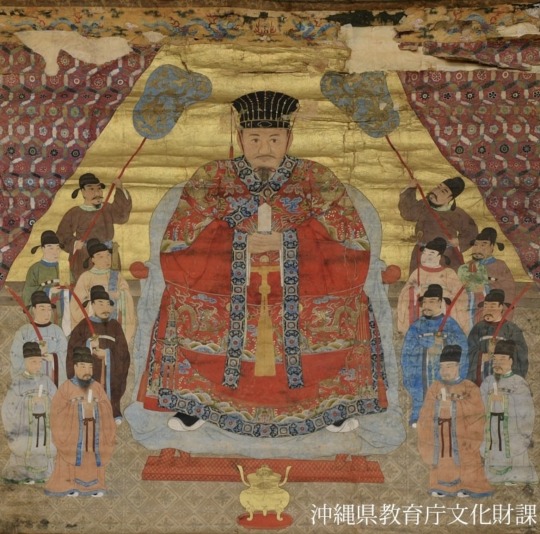
82 notes
·
View notes
Text
i can't take winter anymore, i need the heat of my home country
0 notes
Text
新良幸人×サトウユウ子 (Yukito Ara x Yuuko Satou) - 浄夜(じょうや) (Jouya) (Okinawan)
#okinawa folk pop#新良幸人#サトウユウ子#yukito ara#yuuko satou#浄夜#okinawan#ウチナーグチ#沖縄口#ryu#japonic#asia#japanese#2011#2010s#folk#folksy friday#Spotify
0 notes